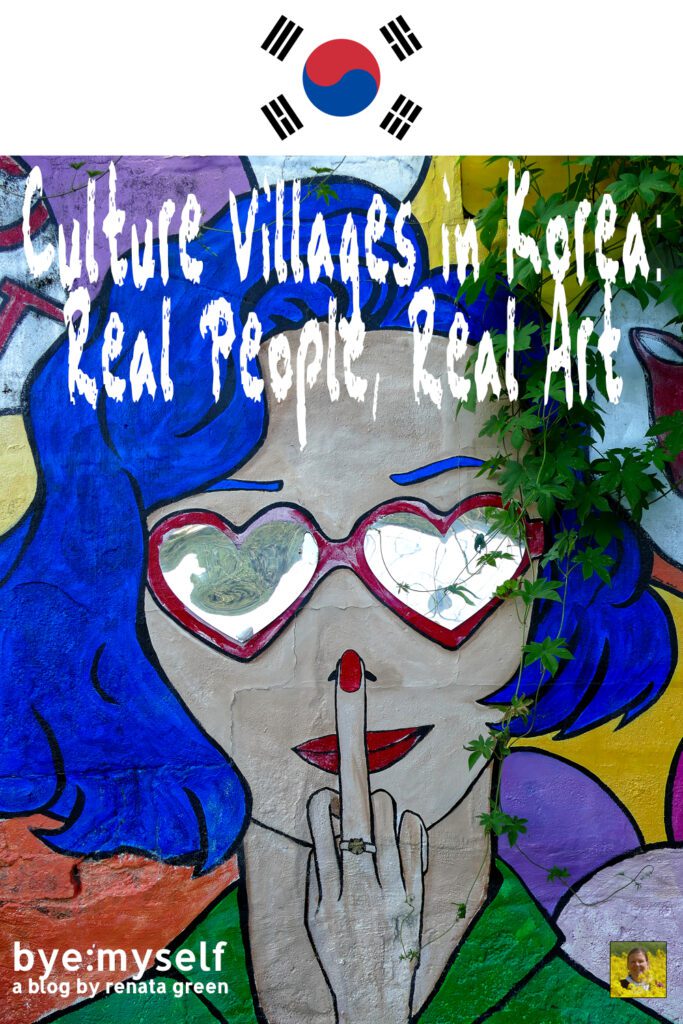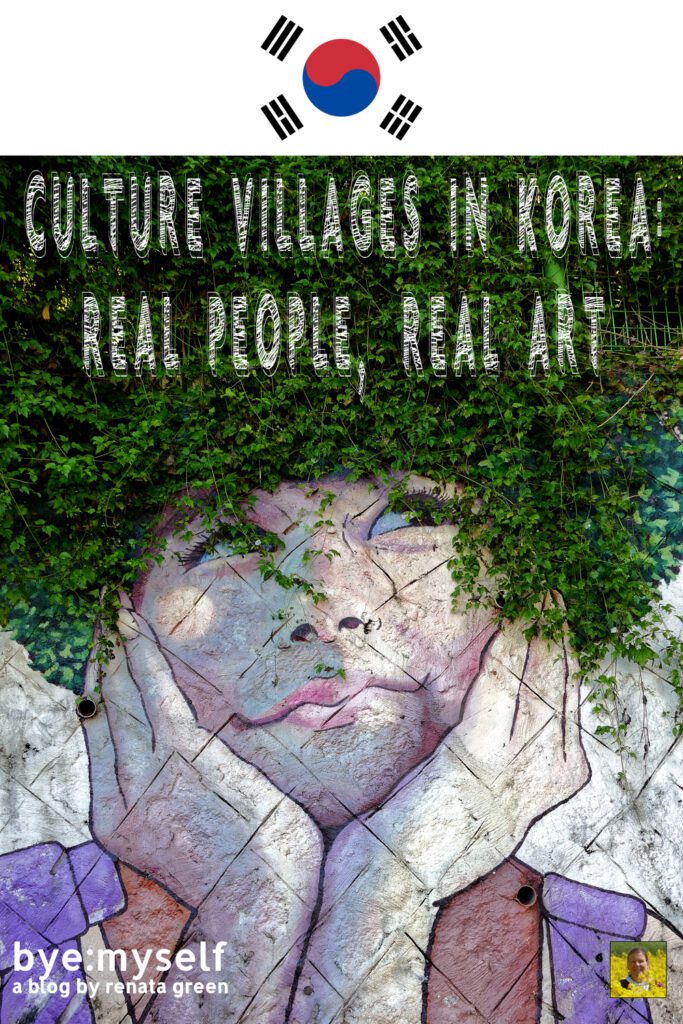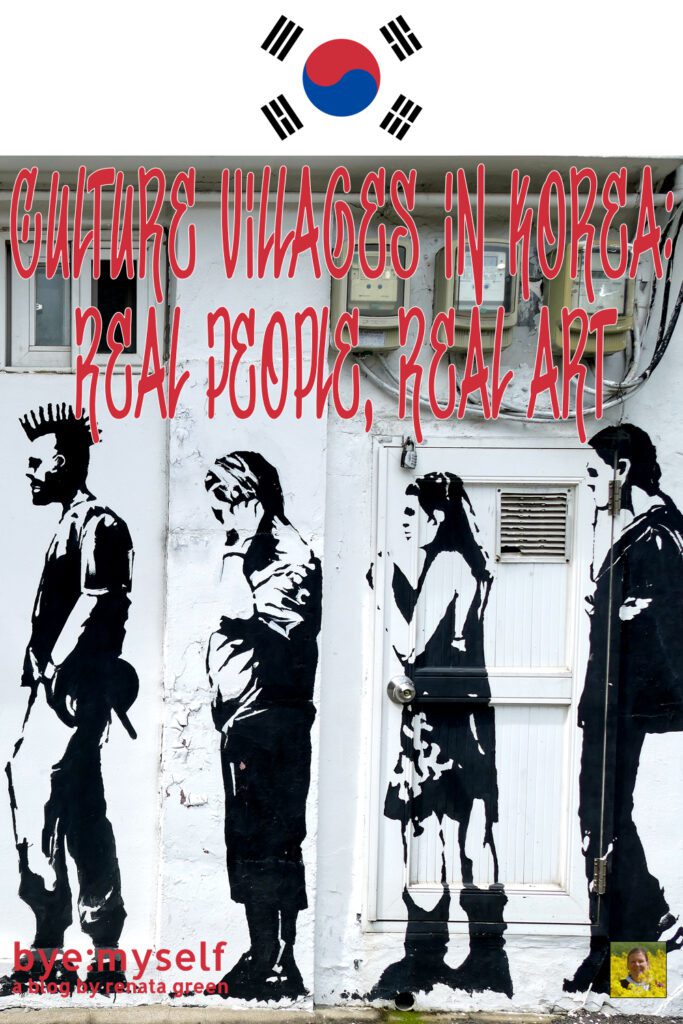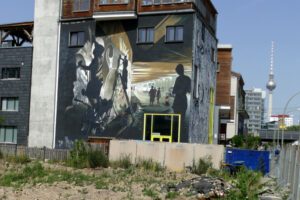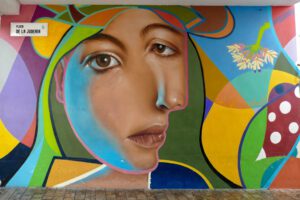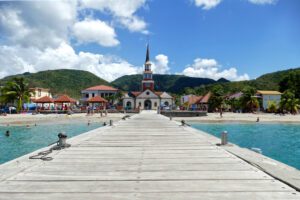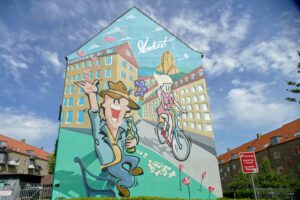In this post, I’m taking you to some of the most prominent Culture Villages in Korea which over the past years have become trendy art districts and hip Instagram backdrops. But despite all the enthusiasm for the wonderful art projects, we shouldn’t forget to also take a look behind the colorful layers of paint, because in Korea’s Daldongnae, behind real art live real people.

Daldongnae
The origin of the Korean Daldongnae, romanticized as so-called moon villages, lies in different eras. Hence, they emerged for different reasons. Firstly, during Japan’s occupation of Korea, the locals tried to escape exploitation by the Japanese by leaving their hometowns and settling on the more secluded mountain slopes.
Later, as a result of fast industrialization, the poor population was pushed to higher areas due to the lack of housing and the associated higher cost of living in the city centers. Hence, the
Daldongnae are dramatically reflecting the ever-changing history and economic development of Korea.
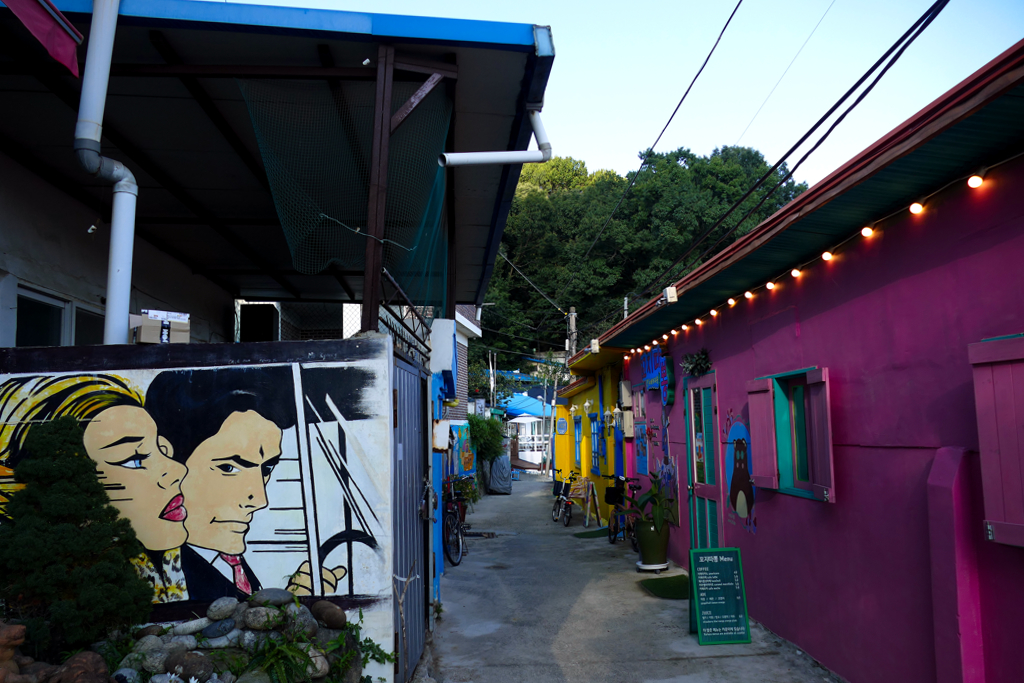
Nevertheless, there were repeated urban planning efforts to demolish those shanty towns as many considered them an eyesore. But where were the inhabitants supposed to go? Hence, as soon as their Daldongnae was demolished, they founded a new one in another spot. After all, also the poor need a roof over their heads.
But is a Daldongnae really just a run-down, dirty place? There are many people who find special value in Daldongnae that cannot be found in other places. Artists have always addressed Daldongnae in their works. Yet, sometimes they romanticized it a bit too much.
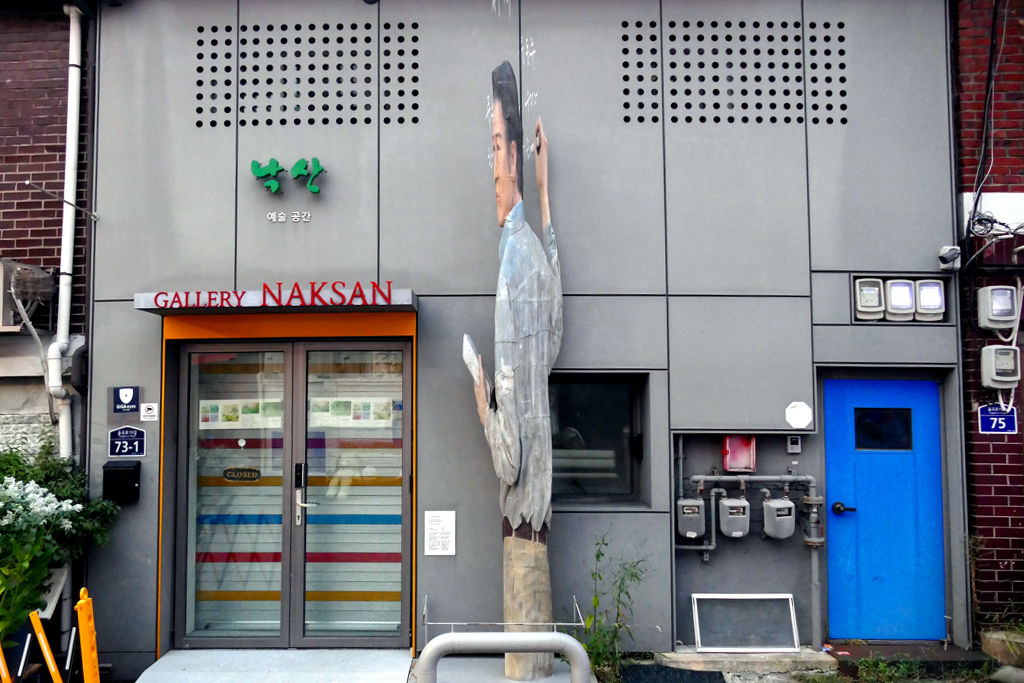
However, it is probably true that the humble life in these areas requires and promotes vital human qualities such as solidarity and mutual respect. Fortunately, there are increasing efforts to preserve these positive factors of the settlements. The houses are being renovated and artistic murals bring beauty and joy to the impoverished neighborhoods. Also, there are multiple efforts to alleviate residents’ hardship, such as providing briquettes free of charge to low-income people.
Over the Moon
But with all the support for the Daldongnae, one should be wary and not lose sight of the big picture. Because far too often, beautification campaigns lead to uncontrolled gentrification, in which poverty serves as a macabre backdrop for shabby chic. When poor neighborhoods become mere tourist attractions, something is terribly wrong. This can already be observed in the probably best-known Daldongnae in Busan, the Culture Village of Gamcheon.
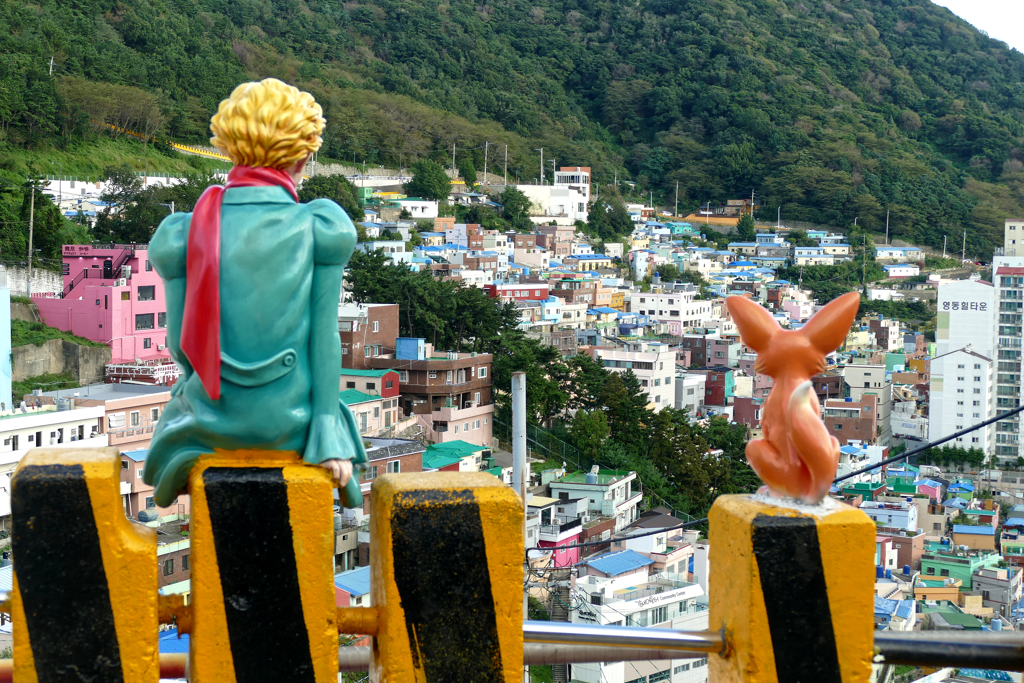
Hence, we can only hope that the development of the Gamcheon Village will go in a favorable direction, primarily for its residents.
Ihwa Village in Seoul
King Yeongjo of the Joseon dynasty made Seoul Korea’s most important trading center in the 18th century.
During the Korean War, however, Seoul changed hands between North Korean and South Korean forces four times. Obviously, the merciless fights left the city heavily damaged: At the end of the war, around 200,000 buildings were in ruins. In addition, impoverished and homeless refugees had fled to Seoul.
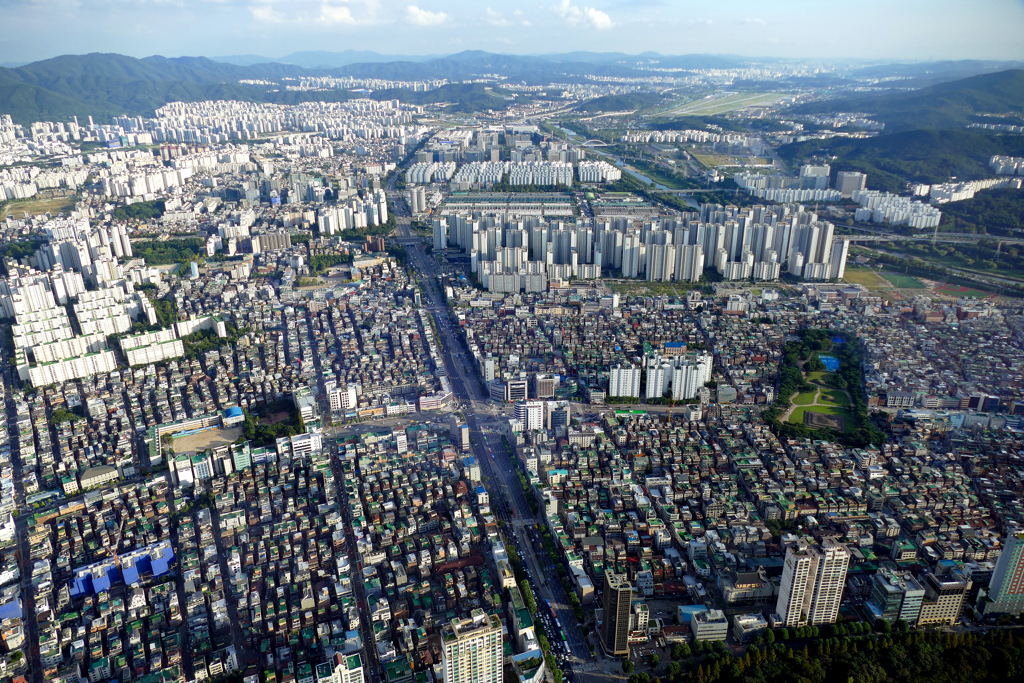
However, reconstruction and modernization began right after the war. South Korea’s rapidly growing economy attracted workers to the developing city. Also, from the 1970s, Seoul’s area greatly expanded as it annexed a number of adjacent towns and villages.

But this economic triumph of some citizens left others far behind. They did not have the privilege to move into the newly constructed mirrored skyscrapers. Instead, they continued to live in simple accommodations in Seoul’s shanty towns. To this day, the city’s largest slum lies just behind the magnificent Lotte complex in Sincheondong.
Saved by the Art
Not all of the poorer people’s neighborhoods fell victim to the construction boom. An inspiring example is the Ihwa Culture Village in Seoul’s Dongdaemun district.
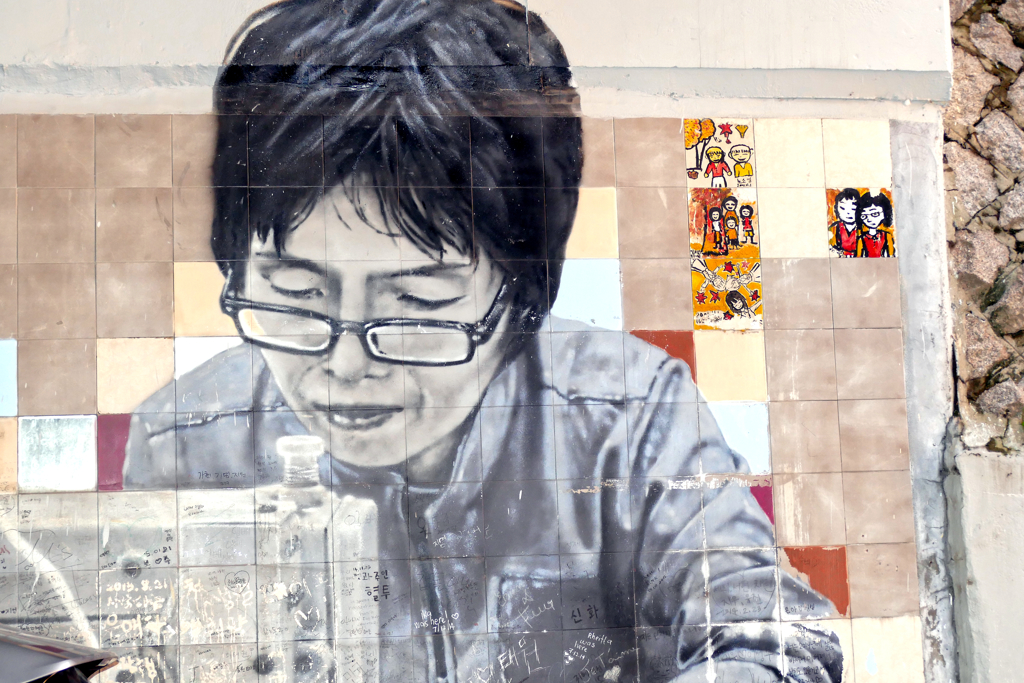
It is one of Seoul’s oldest neighborhoods and is located just below Naksan Park. As one of Korea’s so-called moon villages, its small houses are stuck to the old city walls. Here, refugees joined the working-class citizens after the end of the Korean War.
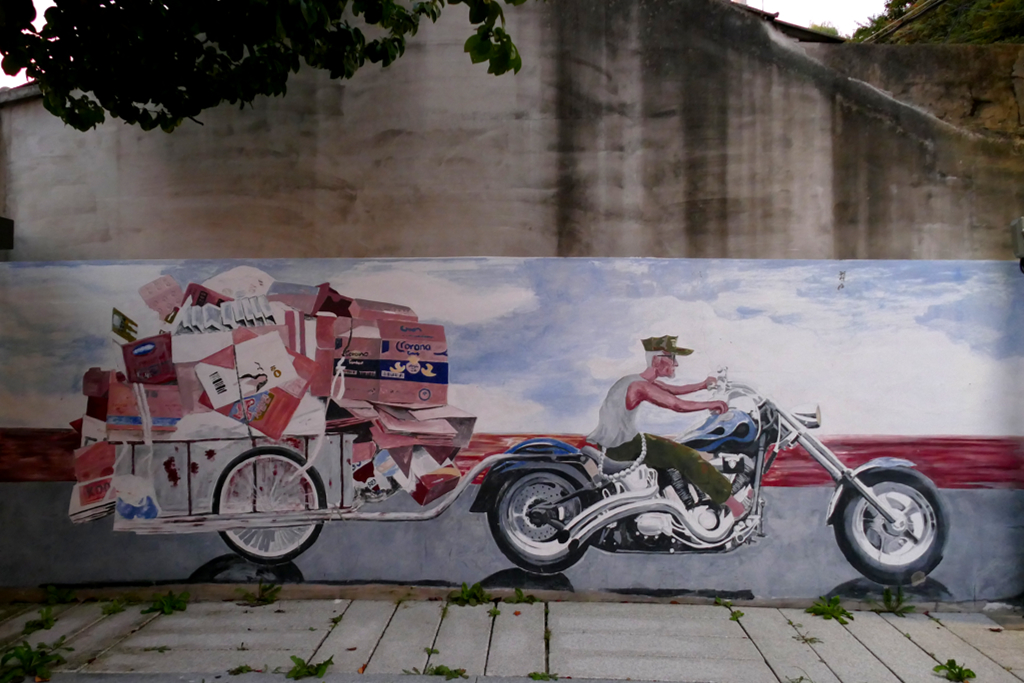
Nevertheless, by 2006, the Ihwa Village was decaying and designated for demolition. But then, the local government came up with their Art in the City campaign which was designed to improve conditions in some impoverished areas through art. About 70 artists contributed murals and installations.
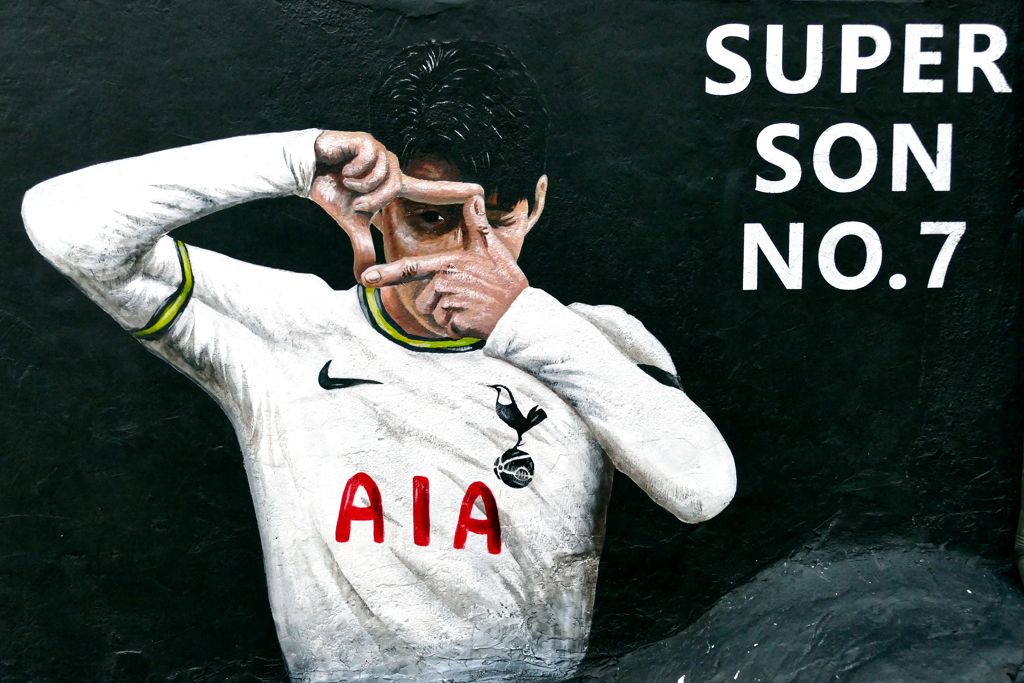
Yet, this alleged improvement didn’t make the villagers happy for long. Over the years, the artwork on the façades – and probably also the picturesque alleys – had attracted large tourist crowds. Taking pictures without respecting the residents’ privacy, they are loitering, littering, and laughing until late.
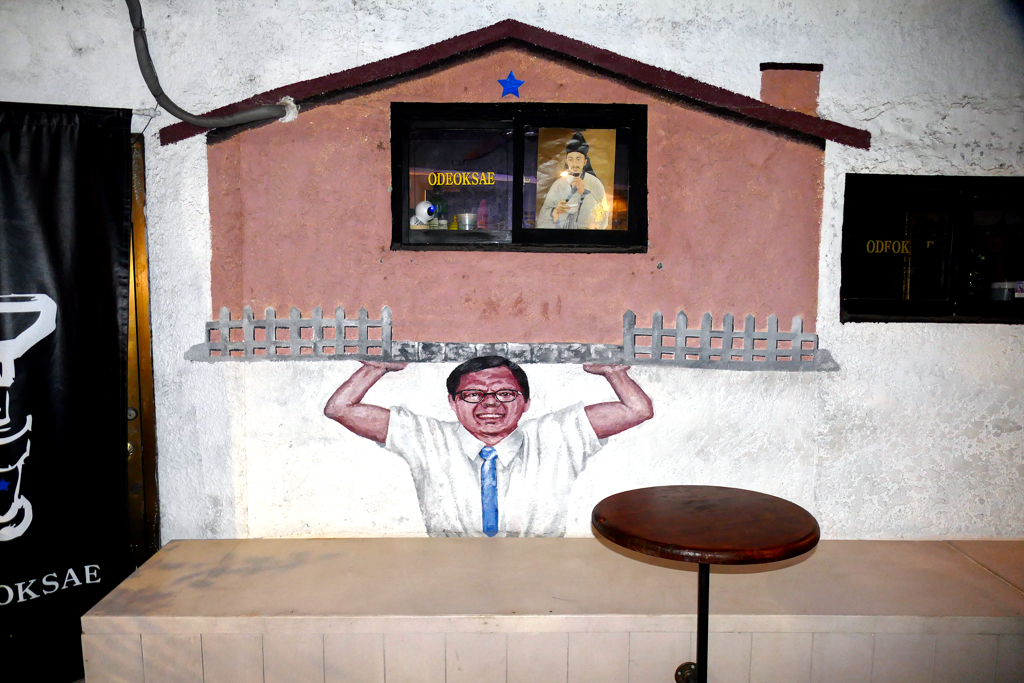
Therefore, in April of 2023, five residents had enough: Unwilling to bear the noise and disturbance any longer, they covered up some of the murals with gray paint.
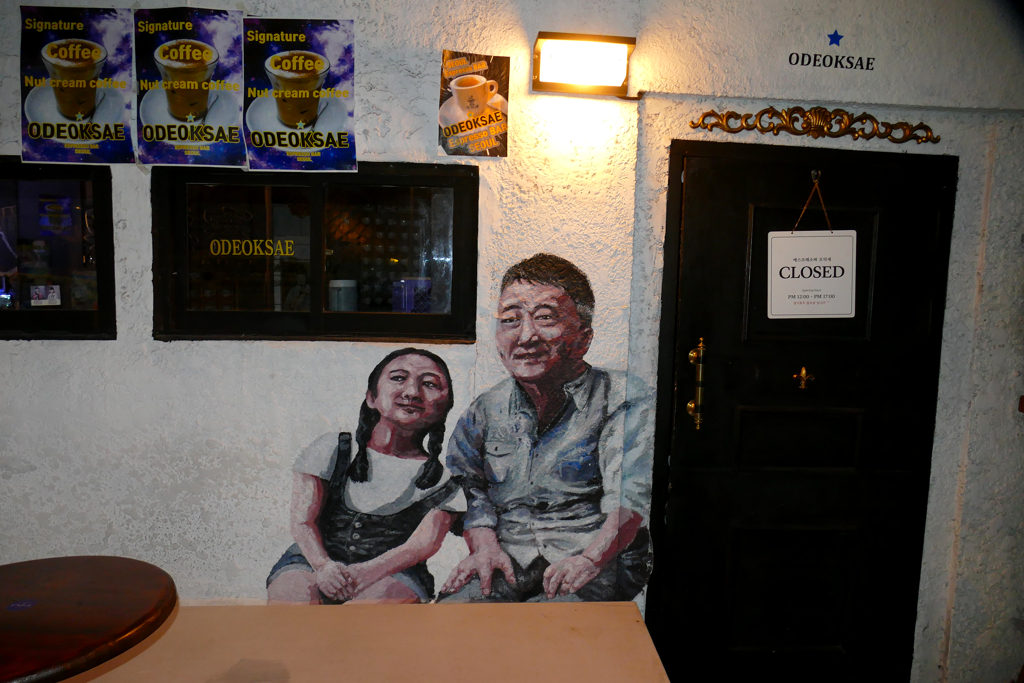
So please, don’t be that ugly tourist. Be respectful and keep it down.
The Ihwa Village was only one of many amazing places I visited during my stay in Seoul. Wanna see what else the city has in store? Then rush over to my guide Best Things to Do in SEOUL: The Must-Dos And the Hidden Gems.
Jaman Mural Village in Jeonju
Located about 230 kilometers south of Seoul, Jeonju looks back at a long history. Already during the Kingdom of Baekje, it was a center of the region albeit at that time under its former name Wansan. However, Jeonju is also the hometown of the Jeonju-Yi family, the founder of the Joseon Dynasty.
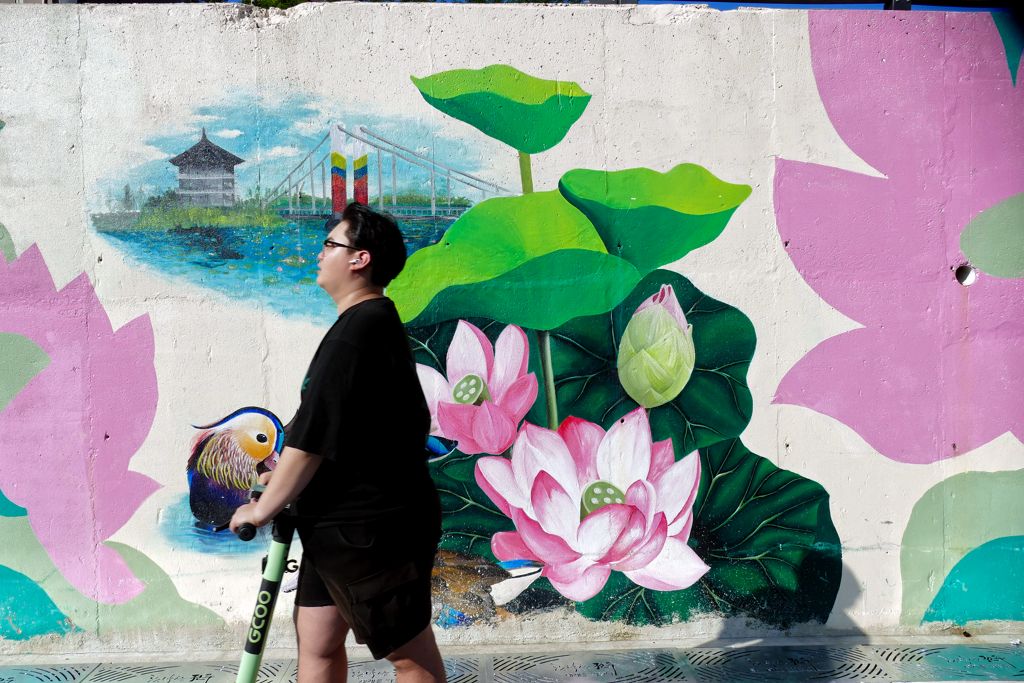
Therefore, to this date, Jeonju’s most famous feature is its old town. 800 well-preserved historic Korean houses, so-called Hanoks, make the Jeonju Hanok Village the largest contiguous traditional residential area in Korea.
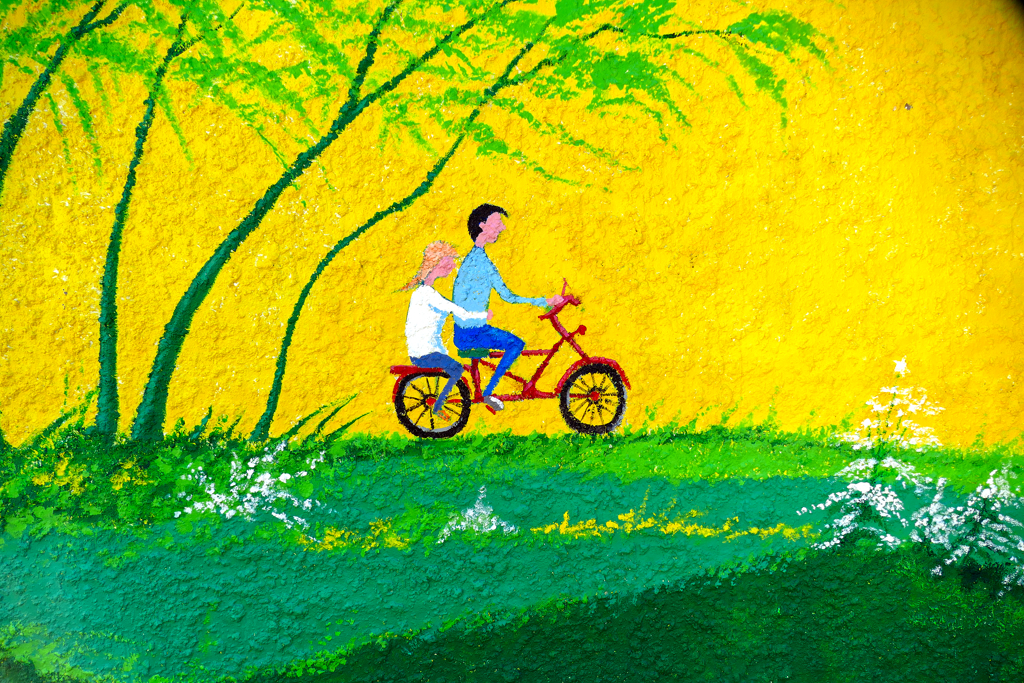
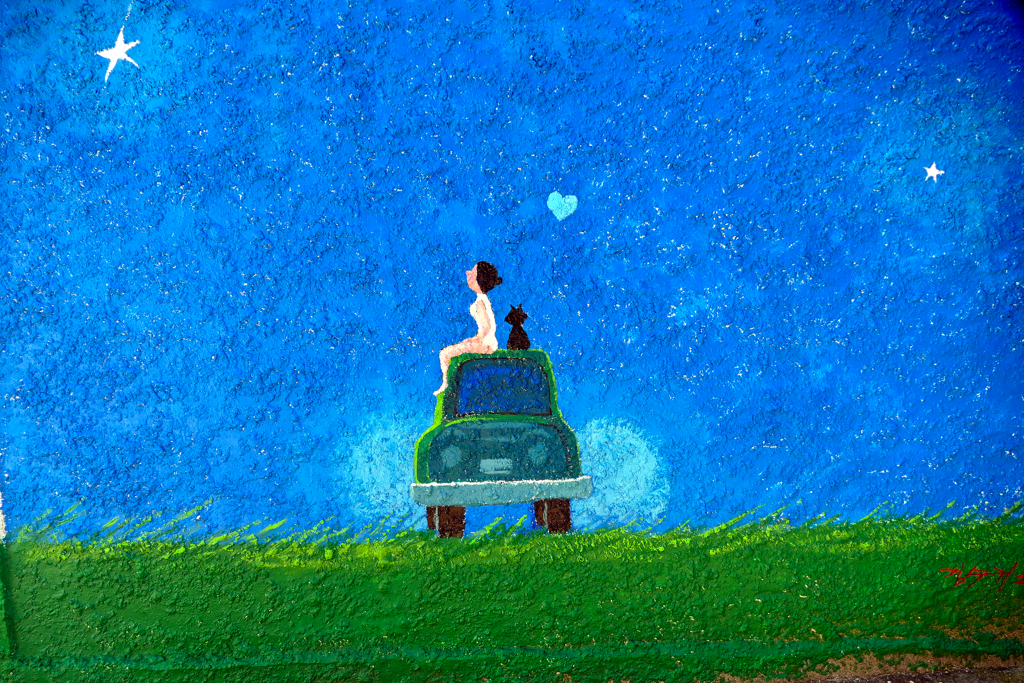
But not all parts of Jeonju are lavish with glamor and financial resources. Jaman Village is one of Korea’s so-called Daldongnae. The village is located on the ridge between Omokdae and Imokdae along the foot of Seungamsan Mountain.
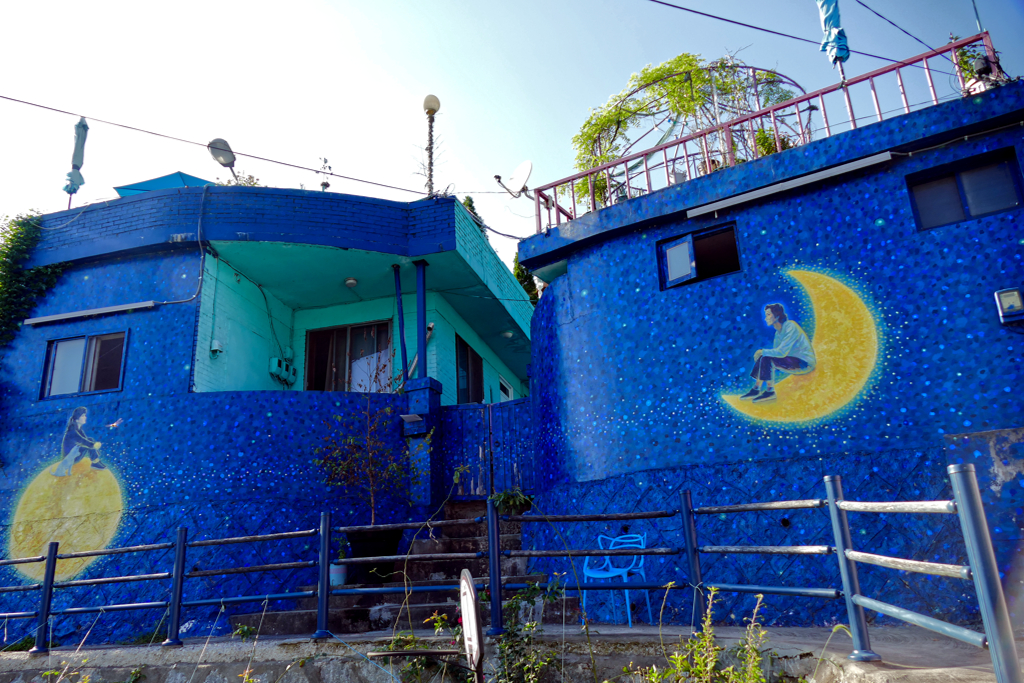
Many local artists have transformed the former shantytown into a trendy neighborhood with their murals in bright, friendly colors. Obviously, the works cannot always compete with murals in Paris, London, or Berlin in terms of size or artistic value. The village is also by far not as spacious as the famous mural villages in Seoul or Busan.
It Takes a Village
Nevertheless, it is obvious that the residents have put a lot of effort into creating a beautiful environment. There are a few small shops and cafes with balconies from where you have a nice view of the southern part of Jeonju Hanok Village.

Since the Jaman Mural Village is built on a really very steep slope, walking around can be a bit of a physical challenge. Above all, you should definitely make sure to wear suitable, hence sturdy, footwear.

Also, always keep in mind that this is not an open-air gallery or an amusement park, but a residential area.
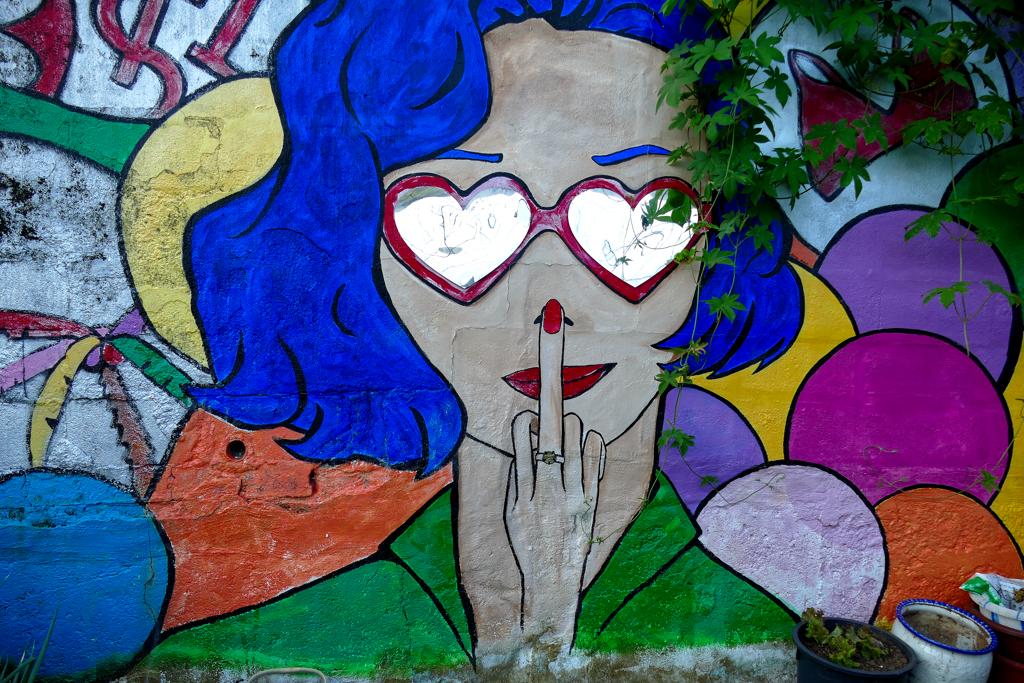
So please, be respectful, don’t look nosily into windows, don’t wander onto people’s private property, and keep it down.
Although the Jaman Village is a great place to visit, most travellers come to Jeonju for the traditional Hanok Village; and so did I. You’ll find a comprehensive guide in my post JEONJU – Cradle of Korea’s Cultural Heritage and Home to the Country’s Best Food.
Gamcheon Culture Village in Busan
Being Korea’s second-largest city and home to the sixth-busiest industrial port in the world, Busan is one of Asia’s most powerful megacities. Yet, many of the city’s 3.5 million inhabitants do not reside in glamorous housing complexes and gated areas, but in Busan’s various Daldongnae of which the Gamcheon Village has gained questionable popularity in recent years.

As a matter of fact, I’m not fond of pointless equations where any city that has more than one canal becomes the Venice of…whatever and a building with more than five floors turns a provincial town into the Manhattan of…wherever. Hence, I find it absolutely ridiculous to compare a district in a Korean metropolis to Santorini or even Machu Picchu just because it isn’t as flat as a potter’s wheel.

So before you get seriously disappointed: Gamcheon doesn’t bear the slightest resemblance to those two legendary places. The only thing they have in common is that they are built on a slope – like the major part of poor working-class neighborhoods in Korea, for that matter.
Becoming an Icon
Gamcheon Village was mainly erected in the 1920s and 1930s. Eventually, around 800 families moved there in the 1950s. As a matter of fact, up until the 1970s, there were only wooden houses in the neighborhood. It was only around the late 1980s that tenants began to construct concrete houses with more than just one storey. Nonetheless, in general, the living conditions in the village remained precarious.
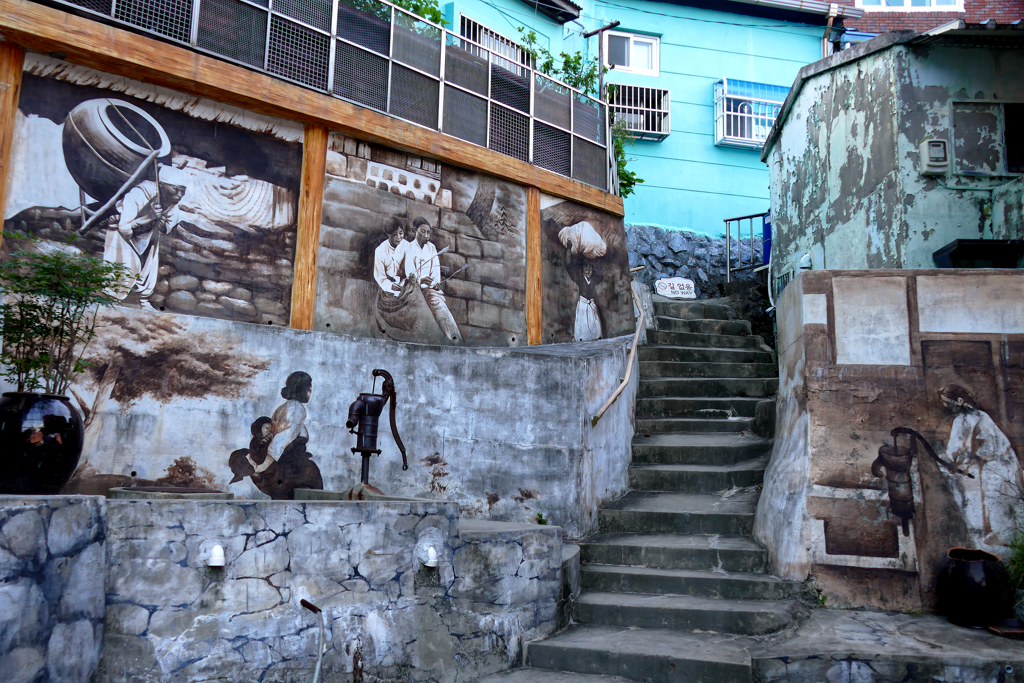
Then, in 2009, the Ministry of Culture, Sports and Tourism initiated improvement measures. As in other Korean cities, too, efforts were made to enhance the village through artistic activities. Artists and art students, as well as residents, came together to repair damage and paint stairs and walls.
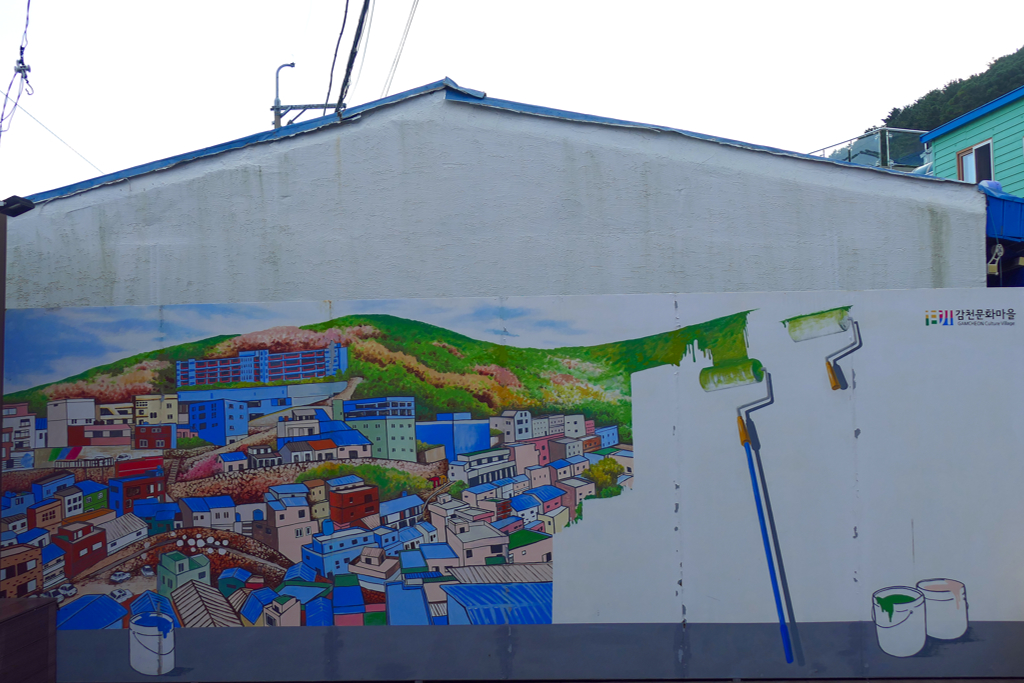
Stores and galleries moved into abandoned houses. More unique installations were added. Gamcheon became one of the most colorful and artistic places in Busan. This way, the village has become one of the most visited tourist attractions in the city.

But is that a good thing?
Well, the villagers see the tourist invasion differently. While some of them are taking part in the remodeling and trying to profit from the tourist crowds, others have decided to sell their houses and leave Gamcheon for good.
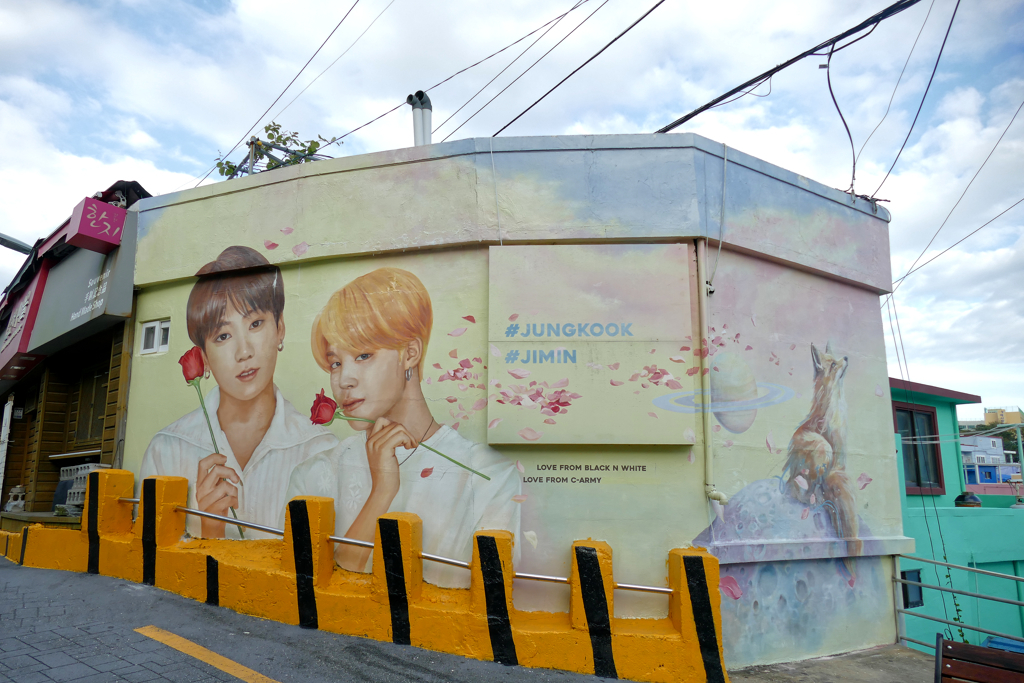
I don’t blame them.
When I visited Gamcheon in the late afternoon, the more comfortably accessible streets and alleys were packed with foreign visitors. At certain murals, tourist were standing in line to have their picture taken. The whole experience had a natural-born theme-park vibe to it.
Gamcheon is nice, but it has lost its purity.
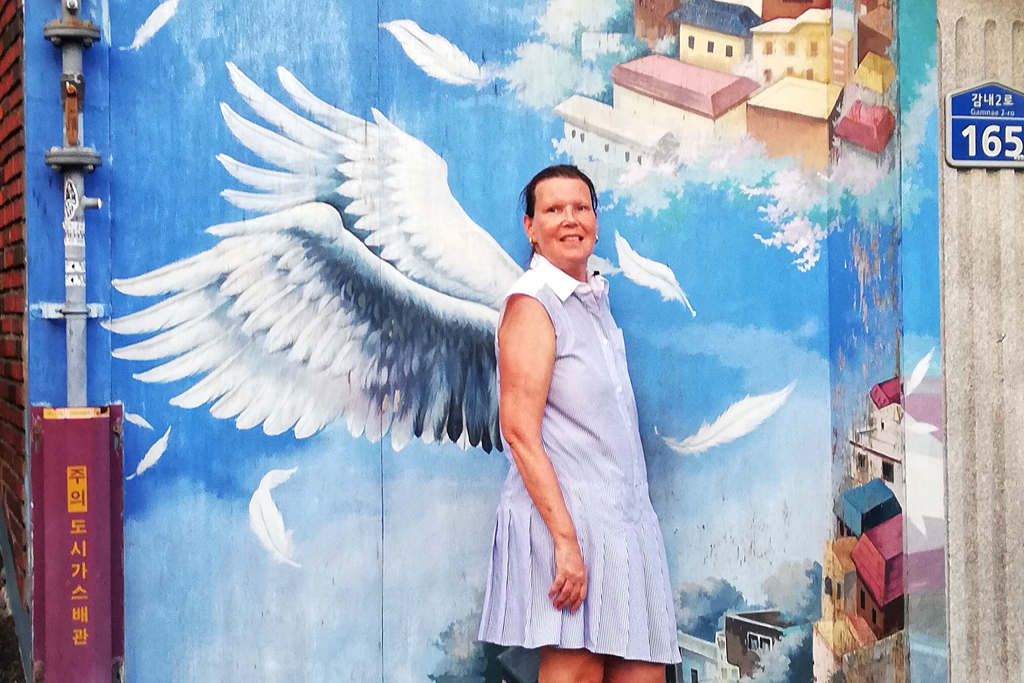
If you prefer getting to know the Village and all its secret spots with a small group of like-minded folks, I recommend you book a guided tour*.
Hynyeoul Munhwa Maul in Busan
Most visitors to Busan visit only the famous Gamcheon Cultural Village. But there are other colorful cultural villages in Busan which I’d argue are far more authentic. In my opinion, Hynyeoul Village, located on the west coast of Yeongdo Island, is the most beautiful one. It is a bright and colorful place right by the sea. Here you can admire art, enjoy snacks and drinks, and take a long walk along the coast, always with the view of the magnificent skyline of Busan’s city center.
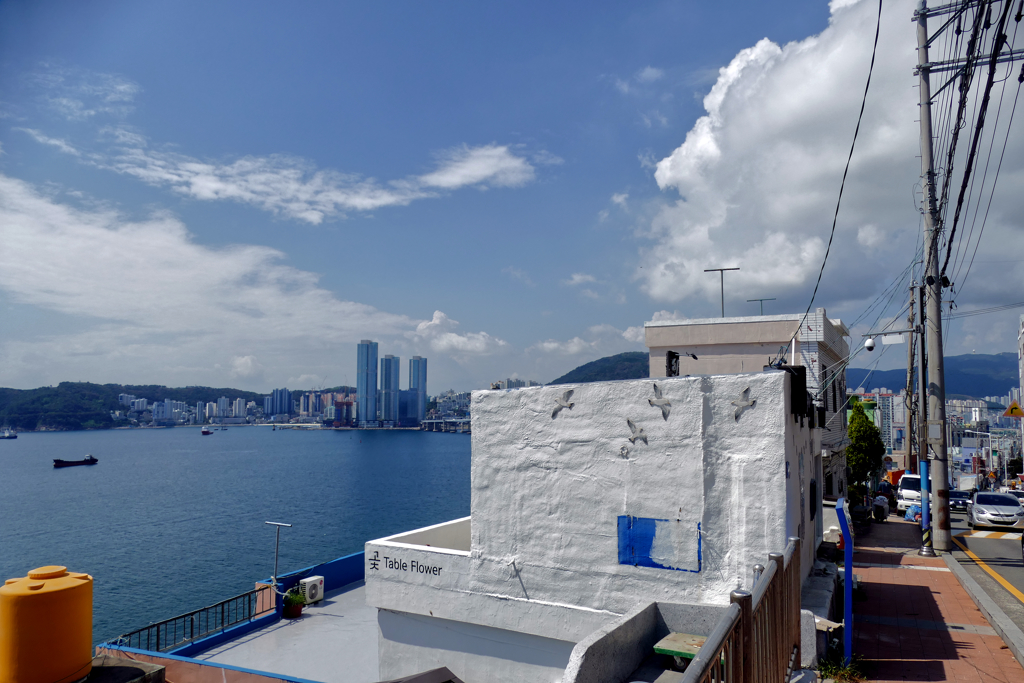
Like all Daldongnae, Hynyeoul was created as a shantytown for refugees who came to the area during the Korean War. To this day, memorial plaques remind us of the pain and misery its inhabitants had to endure in the mid-20th century.

Around 2011, artists started settling in the village. Because the village was in disrepair, rents were low. They were also able to practice their art’n’trade in various forms in this picturesque place. Today you can find – in addition to the natural beauty and the quirky architecture of the settlement – murals and fantastic mosaics.

As you walk, enjoy the beautiful view of the ocean in front of you.
Once you get to the Yeongdo Haneul Observation Deck, it’s time to descend the Rainbow Stairs to the Jeoryeong Coastal Trail. This trail opened in the late 1990s. On a clear day, you can see from here as far as the Japanese island of Tsushima. A little further south you come to the Huin-Yeoul Coastal Tunnel, the perfect backdrop for Instagram your very personal souvenir pictures.
Which Way to Go
Below the main street Jeoryeong-ro, 14 narrow alleys wind between crooked houses. As a matter of fact, Jeoryeong-ro rises towards the south and the height difference to the bank is much smaller at the entrance to the village than further up the road at Yeongdo Haneul Observation Deck. It is therefore advisable to first walk up the gently sloping street and descend the Rainbow Stairs instead of walking on the seafront promenade and having to climb the stairs up.
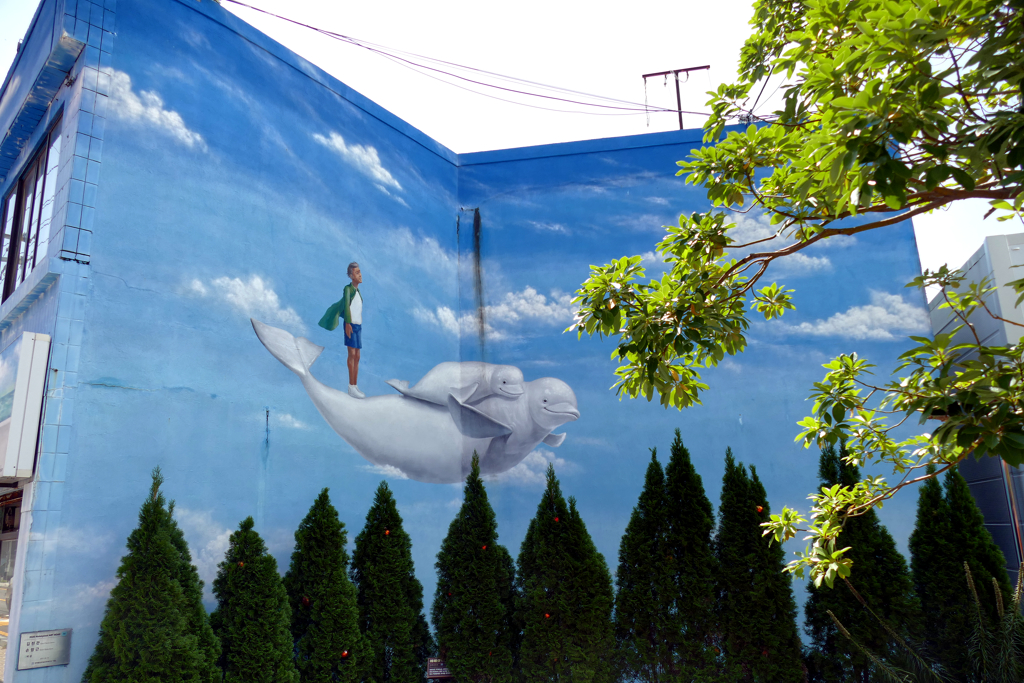
It is not surprising that such a scenic location has often been chosen as a backdrop for films. A couple of movies were filmed here, and there is even a small museum that tells you about all these films and dramas that were shot in the area.
In addition to some shops selling high-quality handicrafts, there are also tons of cafés. Most are laid out in a way that you can enjoy the panoramic views of the sea and Busan’s south coast from both the taproom and a terrace.
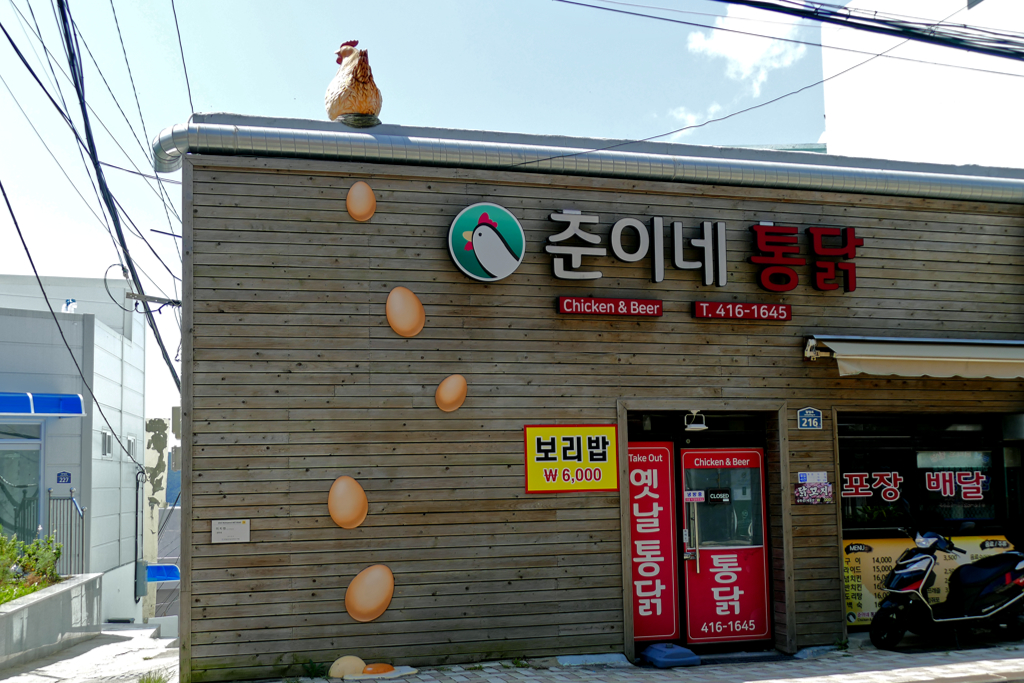
It’s a Chicken by Lee Ji-hyeon
By the way, I was deeply impressed by Busan’s coffee culture. It’s great when a city tour consists of enjoying coffee and dessert in a beautiful artistic atmosphere! By the way, you can read the results of this selfless research in my post Seven Best And Most Beautiful Coffee Houses in Busan. Enjoy – on so many levels!

Mural Celery Men by Cho Hyun Seo.
However, keep in mind that much like any other of the culture villages, this is a residential neighborhood. Therefore, don’t just barge in places that aren’t clearly marked as restaurants, stores, or other public areas.
Hocheon Village in Busan
Probably the least known of Busan’s Daldongnae is Hocheon Village. It is said that in the past, tigers roamed the rough slopes of the mountain. Today they have disappeared, and modest houses have been built on the hillside for Busan’s working-class heroes.
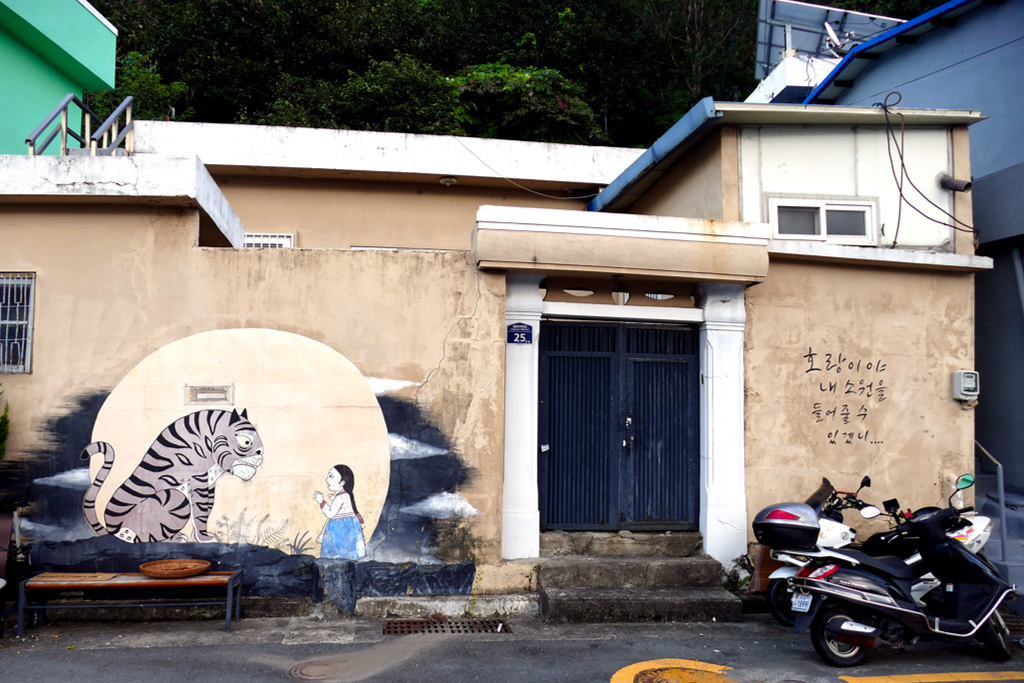
The village became particularly famous a few years ago as the filming location of the K-drama Fight for My Way, which also airs on Netflix.
Just behind the bus stop is the Hocheon Culture Platform. Here, you can visit Namil Bar, a filming location of the drama that makes you feel like being an extra in the drama.
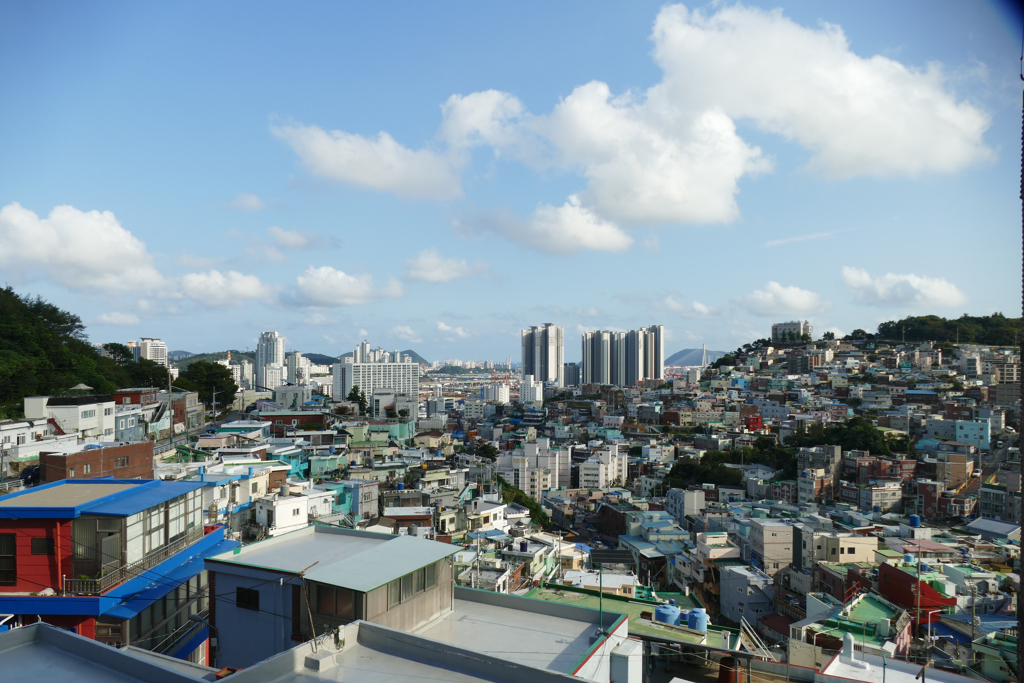
Just below where the road forks is the 180 staircase. These stairs lead steeply down in two rows. As you walk down, turn around and look up: The blue tiles look like a waterfall, and carps appear to glide through the cascading water.
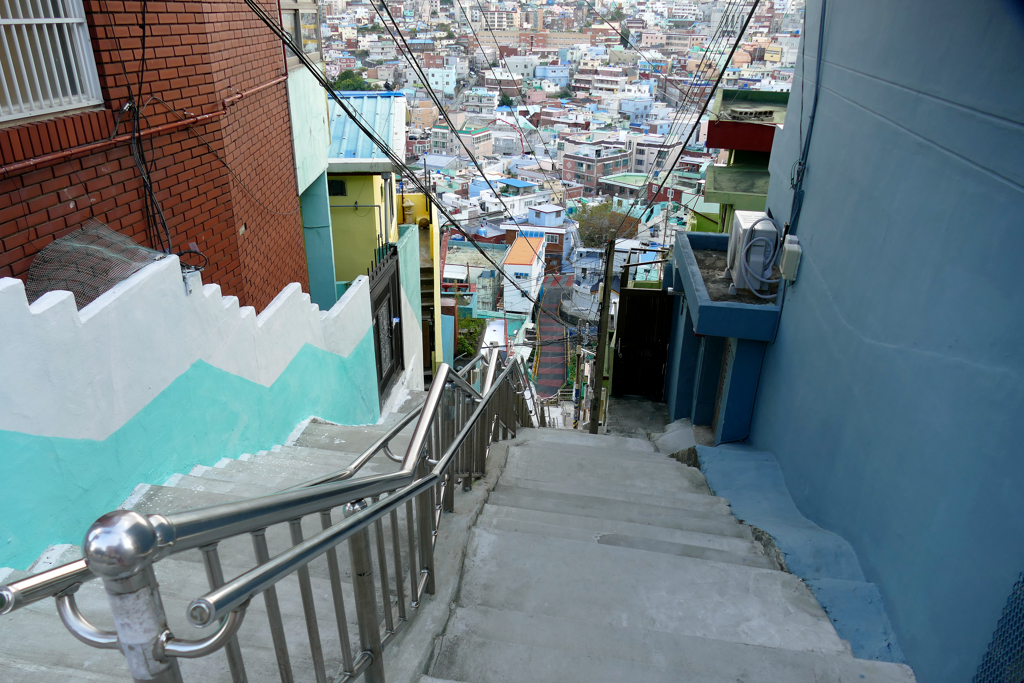
Aside from the Fight for My Way hype, Hocheon Village is famous for its romantic view over the illuminated settlement after dark. So it’s best to come here at night – remember: Korea is a very safe country – when Hocheon is particularly dreamy and captivating. The best way to get up is by bus or taxi. The way back downhill can easily be done on foot.
When it comes to Hocheon Village, you should also remember – especially in the evening – that it is not an amusement park, but the living space of local residents. Be respectful, don’t look curiously in windows, don’t trespass on private property, and speak preferably in whispers.
Exploring these three cultural villages was only one of many inspiring activities during my stay in Busan. Wanna see what else the city has in store? Then rush over to my guide The Perfect Itinerary for Three Days in BUSAN
Seongjingol Mural Village in Andong
As I explained, Daldongnae exist in almost all Korean cities where they have grown more or less out of poverty in inhospitable areas. They are in places where the topography doesn’t allow the construction of those modern yet soulless high-rise housing developments that you’ll find all over Korea.

Seongjingol Village has been traditionally the home of the social lower class. They were dwellings of simple craftsmen and emigrants. In recent years, artists – and inevitably, hipsters – have discovered the idyllic, picturesque neighborhood.
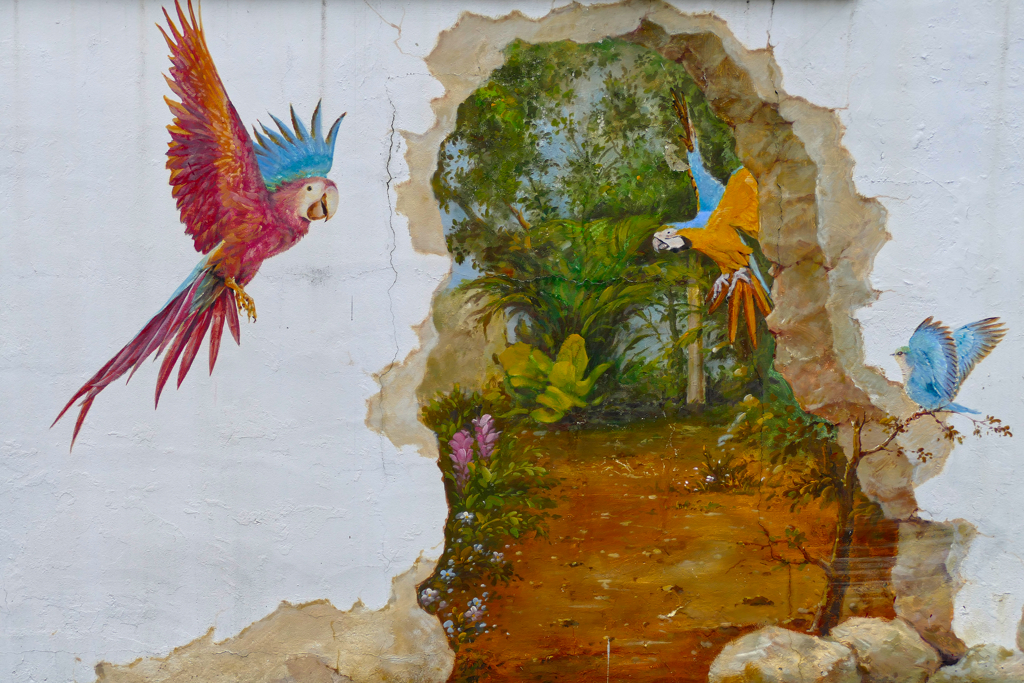
They painted the façades with alluring murals, and artisan coffee shops and craft stores have opened in some of the properties. One can only hope that these picturesque enclaves do not fall victim to brutal gentrification.
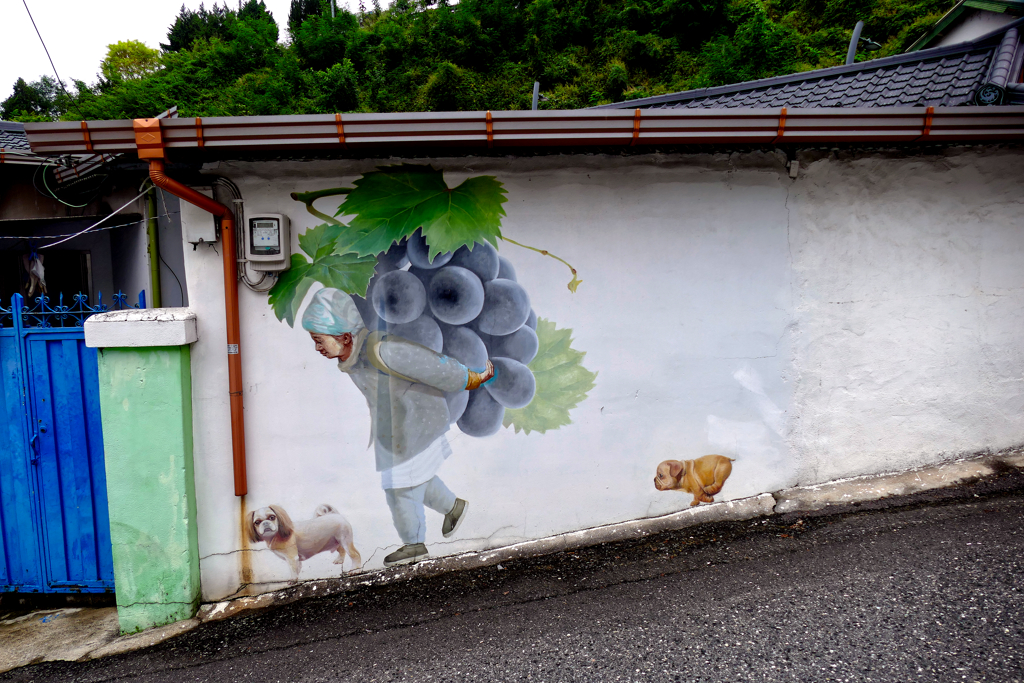
Seongjingol Mural Village was founded in 2009 based on an art project around Andong Dongbu Elementary School. As you make your way up through the narrow streets and alleys, you’ll spot murals and small sculptures and installations on almost every wall.
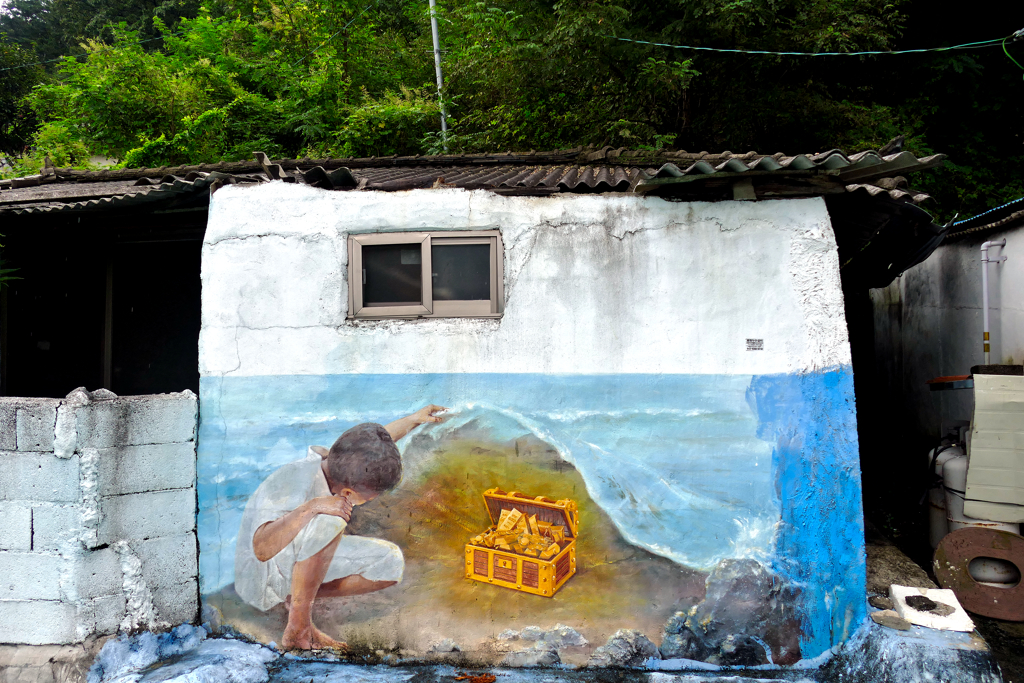
On the top level, I join the statue of a boy taking photos. Together, we enjoyed the view over Andong, a city that unexpectedly and despite the unfavorable weather conditions became an absolute highlight of my trip to Korea.
Most foreign tourists come to Andong to visit the Hahoe Folk Village, a cultural treasure that even made it onto UNESCO’s list of world heritage. Yet, as I prove in my guide How to Experience the Folk Heritage of Korea in ANDONG, there is far more to see – like for instance the very Seongjingol Village.
Pinnable Pictures
If you choose to pin this post for later, please use one of these pictures:

